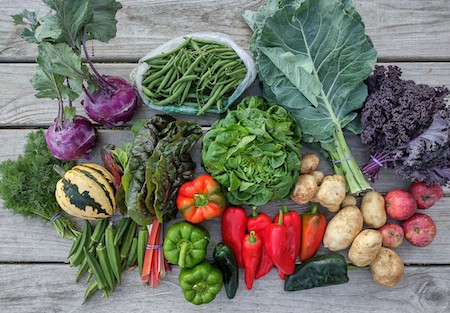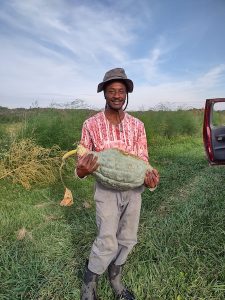
“When you are content to be simply yourself and don’t compare or compete, everybody will respect you.”
~Lao Tzu~
Summer Share Box 17 Crop List
- Potatoes – All Shares

- Purple Kohlrabi – All Shares
- Delicata Squash – All Shares
- Green Beans – All Shares
- Peppers (Bells, Italian Frying, Poblano) – All Shares
- Lettuce – All Shares
- Chard – All Shares
- Dill – All Shares
- Apples – Half Shares
- Purple Kale – Full Shares
- Collard Greens – Full Shares
- Okra – Full Shares
Farmer Notes
Thursday Oct. 21st.

We are experiencing a very strange fall so far this year. Actually it feels like we are still having our summer season. Usually we are dealing with, and worrying about, the low temperatures bringing on a frost or a possible freeze by this date. Freezing temps kill many summer crops and force us to cover various other fall crops that enjoy cooler weather but not the freeze. So we have just been enjoying the milder weather and remain poised for the inevitable cold. Many fall crops however, (like broccoli, cabbage, Brussels, winter squash, etc.) sweeten up appreciably as they go through a frost or two in the field. I felt like the Acorn we delivered in week 16 lacked that sweetness, and we plan to deliver broccoli for week 18. But that’s the deal with farming – every year is unique and you attempt to do the best with the weather that mother nature gives you. With present ongoing irrigation, the fall crops are looking fantastic in our fields.
You may be wondering, “What is that purple alien-looking thing in my box? And what the heck do I do with it?” Good question. It’s Kohlrabi – a lesser-known member of the brassica plant family, which includes cabbage, kale, collards, turnips, broccoli, brussels sprouts, and cauliflower. Kohlrabi is a German word meaning “cabbage (Kohl) turnip (Rabi)”, as it resembles a cross between the two. Kohlrabi’s origin is unknown, though the first written reference to the plant comes from Italy in the late 1500s. It is assumed that Kohlrabi came to America with other cabbage species brought over by European colonizers.
With a similar texture to a cabbage heart but a sweeter taste, kohlrabi can be enjoyed cooked or raw. After the purple outer layer is peeled, you can eat it like an apple or cut it up and put it in a salad or slaw. It is also tasty when roasted, steamed, fried and grilled. And don’t “leaf” behind the kohlrabi greens – they can be cooked or steamed like any other vegetable green!



